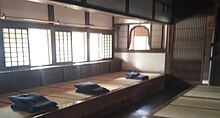This article needs additional citations for
verification. (October 2018) |
| Bairin-ji (Zen Temple) 梅林寺 | |
|---|---|
 Main Gate (sanmon gate) of Bairin-ji | |
| Religion | |
| Affiliation | Buddhism |
| Deity | Nyoirin Kannon |
| Rite | Rinzai school ( Myōshin-ji-branch) |
| Location | |
| Location | Kyo-machi 209, Kurume-shi, Fukuoka-ken 830-0028 |
| Country | Japan |
| Geographic coordinates | 33°19′23.6″N 130°29′58.2″E / 33.323222°N 130.499500°E} |
| Architecture | |
| Founder | Arima Toyōji |
| Completed | 1621 |


Bairin-ji (梅林寺) is a Rinzai temple in Kurume, Fukuoka Prefecture, Japan. Its honorary sangō prefix is Kōnanzan (江南山). It is known as a representative training dojo temple of the Myōshin-ji school. [1]
History
This temple was the bodaiji of the Arima clan and originally located in Fukuchiyama in the Tanba Province, where it was called Zuigan-ji (瑞巌寺). In 1620, when Arima Toyōji was transferred from Fukuchiyama Domain to Kurume Domain in Chikugo Province, he relocated the temple to his new domain and named it Dairyū-ji (大龍寺). It was later renamed to Bairin-ji which is associated with his father Noriyori's posthumous name, Bairin'in-den (梅林院殿) and became a mausoleum of the successive daimyō of the domain. It is located in the western end of Kurume city, next to the Chikugo River.
Along with Shōgen-ji in Gifu Prefecture, Bairin-ji was regarded one of the most rigorous and demanding Zen training monasteries (修行道場) in Japan. [2] However, with the start of the Meiji period the temple fell into disrepair with the loss of the Arima clan patronage and with the new government's haibutsu kishaku movement against Buddhism. It was reopened in year 1879 by Masters Sanseiken (三生軒) and Toukaiyuzen (東海猷禅), who served as chief priests (abbot). [3] The temple is regained today a main zen temple, and the main training temple of the Rinzai Sect in Kyushu, where regular meditation is practiced and taught to monks and lay people.
Cultural properties
The temple is a treasure trove of some 600 cultural assets. The collection includes the silken hanging scroll of three Buddhas called Shaka Sanzon (釈迦三尊) and a painting of Mt. Fuji by renowned Edo-period painter Ogata Korin (1658-1716). [4] Other Edo period cultural assets in the temple include folding screens from Tohaku Hasegawa, and fusuma (Japanese sliding door) paintings in the Kano style. [5] The colored silk wooden Avalokiteśvara statue in the main hall is the work of the Kamakura period.
Garden and plum blossoms

The Gaien (外苑) is a garden which is adjacent to Chikugo River side to the north side. Approximately 30 species of 500 plums donated by the citizens, and many azaleas are planted in the garden. It was opened as a park in 1958 to commemorate the 350 years old of the founding priest, Umon Genkyū Zenji (禹門玄級禅師). [6]
The temple's name, Bairinji, translates to Plum Grove Temple. The plum trees, flower mid-February to mid-March, adding a streak of pink and white to the temple grounds. The blossoms are quite fragrant, and many visitors go to the temple to enjoy a cup of tea and sweets beneath the flowering trees. [7]
Arima clan cemetery

On the grounds of Bairin-ji is a cemetery with the graves of the Edo period Arima clan daimyō of Kurume Domain and their families, as well as their deceased vassals. This was designated a National Historic Site in 2021. [8] It was the practice of the Arima clan to construct the grave of a daimyō who died while in residence in Kurume at Bairin-ji, whereas if he died while on sankin kōtai duties in Edo, the grave would be erected at the clan's Edo bodai-ji of Shoun-ji in Hiroo. Thus at Bairin-ji are the graves of the 1st daimyō, Arima Toyouji, the 2nd daimyō, Arima Tagayori, the 7th daimyō Arima Yoriyuki and the 10th daimyō Arima Yorinaga.
The cemetery contains five memorial chapels, all constructed between 1630-1655. These structures were designated National Important Cultural Properties in 2018. [9]
Sub-temple

There are several temples in Fukuoka, Saga and Kumamoto Prefectures that are closely related to Bairinji Temple. Mostly for the fact that they also belong to the Myoshin-ji Sect and their respective abbots trained at Bairinji. However, the only temple that is a direct sub-temple is a temple that also bears, for the very reason, a partly identical name:
• Yamamoto Bairinji(梅林寺山本分院) is located only ten kilometers to the West of its mother temple, in Yamamoto Village at the foot of the rugged Mino Mountains. [10]
See also
References
- ^ 梅林寺[臨済宗妙心寺派][福岡県久留米市京町209]-お寺めぐりの友 [Bairin-ji] (in Japanese). hakataboy.com. Retrieved October 4, 2018.
- ^ Living and Dying in Zazen - Book written by Arthur Braverman (Living and Dying in Zazen - Five Zen Masters of Modern Japan pp.99-100)
- ^ 「昭和平成禅僧伝 臨済黄檗篇」臨済会編 春秋社発行 2010年 146p 関連法系図の表7
- ^ 梅林寺 [Bairinji Temple] (in Japanese). Japan Online Media Center. Retrieved December 6, 2023.
- ^ Bairin-ji Temple - Kurume Convention Bureau
- ^ 梅林寺 [Bairin-ji] (in Japanese). Kurume Convention Bureau. Retrieved October 4, 2018.
- ^ 梅林寺 [Bairinji Temple] (in Japanese). Japan Online Media Center. Retrieved December 6, 2023.
- ^ "久留米藩主有馬家墓所" (in Japanese). Agency for Cultural Affairs. Retrieved December 20, 2023.
- ^ "有馬家霊屋 春林院霊屋" (in Japanese). Agency for Cultural Affairs. Retrieved December 20, 2023.
- ^ [1] -Google Maps: Route (and distance) between Bairinji Main Temple to Yamamoto Bairinji Sub-temple
External links
![]() Media related to
Bairin-ji (Kurume) at Wikimedia Commons
Media related to
Bairin-ji (Kurume) at Wikimedia Commons
- Bairin-ji Temple - Kurume Convention Bureau
- Public Domain Image of the 14th Century Shaka Triad Scroll - Public Domain Host Picryl
- Kurume city homepage
- Inner Zen Garden of Bairinji-ji - A short video hosted on YouTube
- In One Minute from Shinkansen Station to Tranquility - A short video hosted on YouTube
- Darkness and Light - Inside of Edo Period Built Zen Temple - A short video hosted on YouTube

